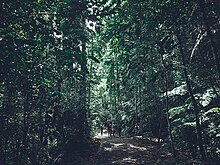This article has multiple issues. Please help improve it or discuss these issues on the talk page. (Learn how and when to remove these messages)
|
| Sinharaja Forest Reserve | |
|---|---|
 View of Sinharaja Forest Reserve with tea garden | |
 | |
| Location | Sabaragamuwa and Southern Provinces, Sri Lanka |
| Nearest city | Rakwana |
| Coordinates | 6°25′00″N 80°30′00″E / 6.41667°N 80.50000°E |
| Area | 88.64 km2 (34.22 sq mi) |
| Established | April, 1978 |
| Governing body | Department of Forest Conservation |
| Criteria | Natural: ix, x |
| Reference | 405 |
| Inscription | 1988 (12th Session) |
Sinharaja Forest Reserve is a forest reserve and a biodiversity hotspot in Sri Lanka. It is of international significance and has been designated a Biosphere Reserve and World Heritage Site by UNESCO.[1]
According to International Union for Conservation of Nature (IUCN), Sinharaja is the country's last viable area of primary tropical rainforest. Over 60% of the trees are endemic, many of them considered rare. 50% of Sri Lankan's endemics species of animals (especially butterfly, amphibians, birds, snakes and fish species)[clarification needed]. It is home to 95% endemic birds.
The hilly virgin rainforest, part of the Sri Lanka lowland rain forests ecoregion, was saved from the worst of commercial logging by its inaccessibility, and was designated a World Biosphere Reserve in 1978 and a World Heritage Site in 1988.
Because of the dense vegetation, wildlife is not as easily seen as at dry-zone national parks such as Yala. The most common larger mammal is the endemic purple-faced langur. | image=

Birds tend to move in mixed feeding flocks, invariably led by the fearless Sri Lanka drongo and the noisy orange-billed babbler. Of Sri Lanka's 26 endemic birds, the 20 rainforest species all occur here, including the elusive red-faced malkoha, green-billed coucal and Sri Lanka blue magpie.
Reptiles include the endemic green pit viper and hump-nosed vipers, and there are a large variety of amphibians, especially tree frogs. Invertebrates include the endemic Sri Lankan birdwing butterfly and leeches.
- ^ "Sinharaja Forest Reserve". UNESCO World Heritage Centre. Retrieved 2020-08-17.